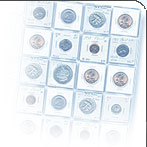Coin Collecting FAQ - Coin Investment
Coin Collecting FAQ written by Chuck D'Ambra, Mike Locke, Michael Caver, Andrew Andison, Mike Marotta, Andrew Tumber, John Muchow, Tony Clayton, Clint Cummins, Lou Coles, Mike Dworetsky and Rita Laws.
This FAQ may be copied for noncommercial use provided that this notice
and all credits to the authors are included unmodified.
Links on the Web to the Coin Collecting FAQ are welcome

18. Risks of investing in coins
19. Bullion coins
20. Rare coins
This material is not investment advice . It is only an introduction to coins sometimes purchased as investments and the risks inherent in this form of investing. More extensive research is advisable before making a decision to purchase any coins for investment purposes. The authors of this FAQ are not responsible in any manner or extent whatsoever for the results of any reader's investment decisions
All investments entail risks. While coin collecting is a rewarding hobby and is sometimes financially profitable, anyone purchasing coins with the expectation that they may be a good investment should understand and be prepared for the risks inherent in such investments.
Counterfeit and altered coins are not uncommon. Various techniques have been used to produce counterfeits. Some are deceptively realistic. Common coins have been altered to appear to be valuable collector coins, e.g. by adding a mintmark. Coins certified by one of the major grading and authentication services (see Slabs) offer a high degree of certainty for authenticity. In the absence of reliable independent authentication, the purchaser should know the diagnostics of genuine specimens of the coin and counterfeits.
Coin values often vary markedly with grade. The buyer must know if the coin is reasonably graded or has any problems, such as cleaning, to determine if the seller's price is fair. The risk of overgraded and problem coins is reduced with certified coins and bullion coins (see topics below). However, the grade assigned by the certification service is only an opinion, and it is not uncommon to find certified coins which, in the opinions of other experts, are overgraded.
While markets for all commodities rise and fall, precious metal and coin prices can be particularly volatile. This volatility creates both opportunities for sizable returns and for dramatic losses. For example, in 1980 the price of gold peaked at more than $800 per ounce and the price of silver at more than $50 per ounce, approximately double and eight times, respectively, what they are today.
Also to be considered are buy/sell spreads and liquidity. Higher value rare coins are often sold at auction. It may take several weeks or months from contacting the auctioneer to receiving payment (less auctioneer's commission). Coins can be purchased from or sold to a dealer much faster. The difference between dealer buy and sell prices can be substantially higher than the commissions charged by brokers for other types of investments. Therefore, a larger appreciation often must occur before coins can be sold at a profit.
Yet another risk is the possibility of material loss, such as by theft or fire. Storage in a bank vault or home safe may reduce (but not eliminate) this risk, but the added expense of such storage again increases the appreciation necessary before the coin(s) can be sold at a profit.
Because the risks of investing in coins are higher than for many other types of investments, they are not suitable at all for many investors. Even for those investors willing to accept higher risks in exchange for possibly greater returns, at most only a modest fraction of the portfolio (perhaps 5 to 15%) would be recommended by many investment advisors.
Refer to our Coin Investment page for more information.
Coins composed primarily of a precious metal and with no significant value beyond that of the metal are one form of bullion . Prices for bullion coins vary with the spot price of the metal. Many investors prefer coins to other forms of metals, such as bars, because coins do not need to be assayed when sold.
Several governments produce gold bullion coins. Examples include the South African Krugerrand, the Canadian Maple Leaf, the Chinese Panda, and the American Eagle. Each sells for a small premium above the value of the gold in the coin.
Silver and platinum bullion coins are also produced by some mints. For example, the U.S. mint has made Silver Eagles (containing one ounce of silver) each year since 1986. Uncirculated silver eagles sell at a premium above spot silver, generally ranging from $1.35 to $4.00 per coin (depending on quantity, dates and source).
Common date circulated silver coins are also bought and sold as bullion. U.S. dimes, quarters and half dollars dated 1964 or earlier are 90% silver and were made with 0.723 ounce of silver for each dollar in face value (as some metal may have been worn off from circulation, 0.715 ounce/dollar is often used to estimate the amount of silver still present). These coins were often melted and refined to other forms.
Refer to our Silver Coins and Gold Coins pages for more information.
Investments in rare coins are made with the expectation that their numismatic value will increase. Technically, "rare" means very few examples are known (e.g. no more than 75 to earn that designation on the Sheldon Rarity Scale), but coins with much higher populations are sometimes promoted as "rare coin investments."
Coins sometimes purchased for investment purposes include ancients, Morgan dollars, Walking Liberty halves and older gold coins. High grade coins are usually preferred.
An investor might include some rare coins in his or her portfolio if there is reason to expect demand from collectors and/or investors for those specific coins to increase. A savvy investor understands the risks inherent in coin investments and takes appropriate measures to minimize them.
Refer to our Rare Coins page for more information about rare coins.





